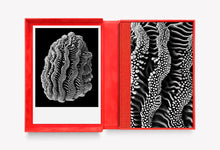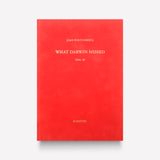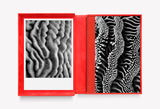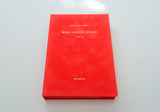Custom made velvet box includes:
A signed first edition book and one silver gelatin print
paper size of print: 16x23cm
Choice of 5 images, each print has an edition of 5+1AP
The price of the edition increases gradually, starting at 360.-€
*
*
What Darwin missed (Teil III), by Joan Fontcuberta
What if Charles Darwin had discovered more species during the historic voyage of the Beagle? Would he have the same ideas about evolution that he had after studying the coral reefs? Or did the British naturalist skip any underwater revelations while exploring the Galapagos and Cocos (Keeling) Islands?
In the 1830s, Darwin's interest in corals started his greatest scientific contribution. For Joan Fontcuberta (Barcelona, 1955) science is a set of provisional truths, and those same coral reefs might hold the key to new findings. The Catalan photographer, curator, essayist and lecturer started following Darwin’s footsteps in the Pacific and Indian Ocean, and soon found out about a failed scientific expedition to illustrate these corals.
Alfred Ehrhardt’s legacy
Alfred Ehrhardt was a German nature photographer, filmmaker and author of award-winning works about coral species. In 1938 he was commissioned to integrate a new expedition to the coral reefs that originated Darwin’s theories, but the Second World War truncated his plans.
Ehrhardt’s work triggered Fontcuberta’s curiosity. He spent months between the Alfred Ehrhardt Foundation archives in Berlin, European natural history museums (Berlin, Paris, Barcelona, Bologna, Granollers), and the waters of Galapagos and Cocos (Keeling) Islands. Everywhere he took pictures of corals, and the results exceeded everyone's expectations.
A new lens on corals
What Darwin missed (Teil III) not only brings Alfred Ehrhardt’s legacy back to life, but also portrays unknown coral species through Fontcuberta’s unique lens. His amazing images point to the tension between reality and fiction, or between natural and artificial, a subject he’s been covering throughout his career.
Decades after exhibiting his reference projects about rare plants (Herbarium) and animals (Fauna) all over the world, Fontcuberta was fascinated by the elusive nature of corals. These organisms were historically seen as hybrids between plants and minerals: a celebration of life’s forms that shaped Alfred Ehrhardt’s photographs and the New Objectivity movement that he embraced in Germany.
However, What Darwin missed is more than a homage to Ehrhardt’s elegant style. A new species can be found among the unbelievable variety of corals displayed by Fontcuberta. The "Cryptocnidaria" adapts to extreme conditions like unusual temperatures, pH changes or high-water pressure in the deep sea. While scientists analyze if a genetic mutation caused by chemicals or radioactivity could have helped "Cryptocnidaria" to survive, its mere existence challenges the gradual evolution of species proposed in Darwin’s model.
Nature photography
Almost a century after Darwin published his first study about coral reefs, the Hamburg Natural History Museum invited Alfred Ehrhardt to photograph its collection of corals. Their collaboration was about to continue with that new expedition to Galapagos and Cocos (Keeling) Islands. The outbreak of the war canceled their trip, and in 1943 the museum was destroyed in a conflagration.
Fontcuberta’s often provocative and playful views on science focused on recreating that forgotten voyage. Our perception of nature and image have come a long way since Darwin and Ehrhardt, and the magical underwater images of What Darwin missed are the living proof of that. As Joan Fontcuberta says, his interest in photographing nature allows him to reflect on the nature of photography.
Joan Fontcuberta: What Darwin missed was first exhibited in 2024 at the Alfred Ehrhardt Stiftung in Berlin. Its book version published by Kominek Books includes texts by Joan Fontcuberta, Rosa Russo and Christiane Stahl, and 60 illustrations. At the same time, the recent collaboration between Fontcuberta and the Kominek Gallery also includes a new edition of his classic projects Herbarium (1982-84) and Fauna (1985-89).
Exhibition Link>>>>
Joan Fontcuberta: What Darwin Missed
Sep 14 – Dec 22, 2024
Vernissage on Friday, September 13, 2024, 7pm
The artist will be present.
Alfred Ehrhardt Stiftung
Auguststr. 75
10117 Berlin, GERMANY
10117 Berlin, GERMANY











































